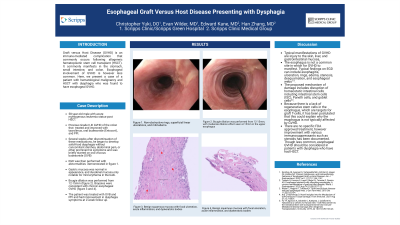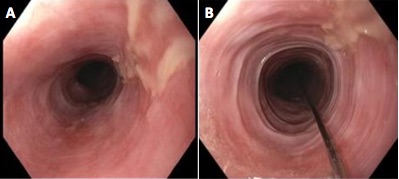Monday Poster Session
Category: Esophagus
P2273 - Esophageal Graft vs Host Disease Presenting With Dysphagia
Monday, October 28, 2024
10:30 AM - 4:00 PM ET
Location: Exhibit Hall E

Has Audio

Christopher Yuki, MD
Scripps Clinic
San Diego, CA
Presenting Author(s)
Christopher Yuki, MD1, Evan Wilder, MD2, Han Zhang, MD2
1Scripps Clinic, La Jolla, CA; 2Scripps Clinic, San Diego, CA
Introduction: Graft versus Host Disease (GVHD) is an immune-mediated complication that commonly occurs following allogeneic hematopoietic stem cell transplant (HSCT). It commonly manifests in the stomach, small intestine, and colon. Esophageal involvement of GVHD is however less common. Here, we present a case of a patient with hematological malignancy and HSCT with dysphagia who was found to have esophageal GVHD.
Case Description/Methods: Our patient is a 58-year-old male with acute myelogenous leukemia status-post HSCT, with previous Grade II-III GVHD of the colon that was treated with tacrolimus and budesonide. Once symptoms resolved, immunosuppresants were eventually discontinued. Several weeks after discontinuation of these medications, he began to develop solid-food dysphagia without concomitant diarrhea, abdominal pain, or other prominent GI symptoms and was briefly started on oral viscous budesonide (OVB), which was then held for several days leading up to EGD.
EGD was performed, which was notable for non-obstructive rings, superficial linear ulcerations, and mild edema (Fig 1A). Gastric mucosa was normal in appearance, and duodenal mucosa only notable for mild erythema in the bulb. Bougie dilation was performed from 12-15mm, with moderate dilation effect seen at 15mm in the upper esophagus (Fig 1B). Biopsies showed focal ulceration, acute inflammation, and dyskeratotic bodies in the upper esophagus consistent with chronic esophageal GVHD. Fungal and viral stains were negative. The patient was treated with OVB and PPI and had improvement in dysphagia symptoms at 2-week follow up.
Discussion: Typical manifestations of GVHD are injury to the skin, liver, and gastrointestinal mucosa, however the esophagus is not a common site for GVHD to manifest. Typical findings on EGD can include esophagitis, ulceration, rings, edema, stenosis, desquamation, and esophageal webs. The proposed mechanism of damage includes disruption of homeostatic intestinal cells including intestinal stem cells, Paneth cells, and goblet cells. Because there is a lack of regenerative stem cells in the esophagus, which are targets for graft T-cells, it has been postulated that this could explain why the esophagus is not typically affected by GVHD. There are no specific FDA approved treatments, however improvement with various immunosuppresants such as steroids has been documented. Though less common, esophageal GVHD should be considered in patients with dysphagia who have had HSCT.

Disclosures:
Christopher Yuki, MD1, Evan Wilder, MD2, Han Zhang, MD2. P2273 - Esophageal Graft vs Host Disease Presenting With Dysphagia, ACG 2024 Annual Scientific Meeting Abstracts. Philadelphia, PA: American College of Gastroenterology.
1Scripps Clinic, La Jolla, CA; 2Scripps Clinic, San Diego, CA
Introduction: Graft versus Host Disease (GVHD) is an immune-mediated complication that commonly occurs following allogeneic hematopoietic stem cell transplant (HSCT). It commonly manifests in the stomach, small intestine, and colon. Esophageal involvement of GVHD is however less common. Here, we present a case of a patient with hematological malignancy and HSCT with dysphagia who was found to have esophageal GVHD.
Case Description/Methods: Our patient is a 58-year-old male with acute myelogenous leukemia status-post HSCT, with previous Grade II-III GVHD of the colon that was treated with tacrolimus and budesonide. Once symptoms resolved, immunosuppresants were eventually discontinued. Several weeks after discontinuation of these medications, he began to develop solid-food dysphagia without concomitant diarrhea, abdominal pain, or other prominent GI symptoms and was briefly started on oral viscous budesonide (OVB), which was then held for several days leading up to EGD.
EGD was performed, which was notable for non-obstructive rings, superficial linear ulcerations, and mild edema (Fig 1A). Gastric mucosa was normal in appearance, and duodenal mucosa only notable for mild erythema in the bulb. Bougie dilation was performed from 12-15mm, with moderate dilation effect seen at 15mm in the upper esophagus (Fig 1B). Biopsies showed focal ulceration, acute inflammation, and dyskeratotic bodies in the upper esophagus consistent with chronic esophageal GVHD. Fungal and viral stains were negative. The patient was treated with OVB and PPI and had improvement in dysphagia symptoms at 2-week follow up.
Discussion: Typical manifestations of GVHD are injury to the skin, liver, and gastrointestinal mucosa, however the esophagus is not a common site for GVHD to manifest. Typical findings on EGD can include esophagitis, ulceration, rings, edema, stenosis, desquamation, and esophageal webs. The proposed mechanism of damage includes disruption of homeostatic intestinal cells including intestinal stem cells, Paneth cells, and goblet cells. Because there is a lack of regenerative stem cells in the esophagus, which are targets for graft T-cells, it has been postulated that this could explain why the esophagus is not typically affected by GVHD. There are no specific FDA approved treatments, however improvement with various immunosuppresants such as steroids has been documented. Though less common, esophageal GVHD should be considered in patients with dysphagia who have had HSCT.

Figure: Endoscopic findings at initial endoscopy (A) with dilation being performed (B).
Disclosures:
Christopher Yuki indicated no relevant financial relationships.
Evan Wilder indicated no relevant financial relationships.
Han Zhang indicated no relevant financial relationships.
Christopher Yuki, MD1, Evan Wilder, MD2, Han Zhang, MD2. P2273 - Esophageal Graft vs Host Disease Presenting With Dysphagia, ACG 2024 Annual Scientific Meeting Abstracts. Philadelphia, PA: American College of Gastroenterology.
